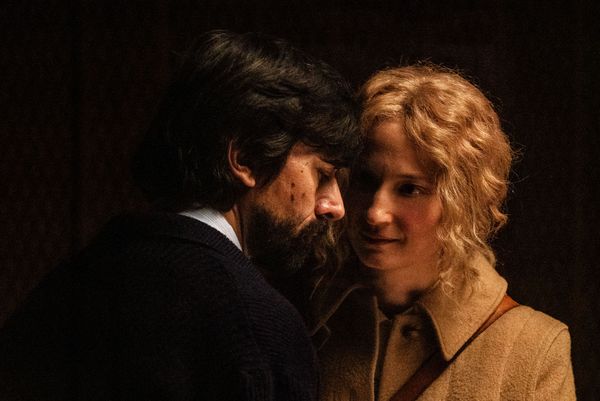 |
| Aldo (Luigi Lo Cascio) with Vanda (Alba Rohrwacher) in Daniele Luchetti’s tightly wound The Ties (Lacci) |
Daniele Luchetti’s The Ties (Lacci), adapted from the novel by Domenico Starnone, with co-screenwriter Francesco Piccolo, which stars Alba Rohrwacher and Luigi Lo Cascio with Laura Morante, Silvio Orlando, Giovanna Mezzogiorno and Adriano Giannini was a highlight of the 2021 virtual edition of Open Roads: New Italian Cinema, presented by Film at Lincoln Center and Istituto Luce Cinecittà in New York.
 |
| Daniele Luchetti with Anne-Katrin Titze on costume designer Massimo Cantini Parrini: “He has great taste, not to mention the fact that he really knows the craft well, he really knows his fabrics.” |
The film begins with a closeup of shoes. Dancing feet - lacci also means laces - hop in a carnivalesque conga line. Children are having fun in their costumes, while Vanda (Alba Rohrwacher) and Aldo (Luigi Lo Cascio) cannot hide on their faces all the bad blood and the doom that is to come. We are in Naples in the early Eighties and the family is about to blow up. 6-year-old Sandro (Joshua Francesco Louis Cerciello) and 8-year-old Anna (Giulia De Luca) are sitting on the couch with their parents, watching a nature documentary about lions and their family ties. Aldo aids the kids with their bath and tells them a good-night story about a road paved with chocolate. Later that night, he tells his wife that “something happened.” Aldo, who works in Rome where he is the host of a literary radio program, has been with another woman.
From Rome, Daniele Luchetti joined me on Zoom for an in-depth conversation on The Ties.
Anne-Katrin Titze: Hi Daniele!
Daniele Luchetti: Nice to meet you!
AKT: Actually we’ve met before!
 |
| Anna (Giulia De Luca), Aldo (Luigi Lo Cascio), Sandro (Joshua Francesco Louis Cerciello), and Vanda (Alba Rohrwacher) |
DL: Yes, I remember, in New York!
AKT: Yes, for Those Happy Years in 2014.
DL: I remember very well, Anne-Katrin.
AKT: Where are you?
DL: I’m in Rome, at home.
AKT: So it’s good afternoon for you! Let’s start with the book. There are obviously changes you had to make. Did you co-write the screenplay with the novelist, Domenico Starnone?
DL: That’s not exactly the case. I did speak a lot with the writer but during the first draft, I did that alone with my co-screenwriter Francesco Piccolo. Because I think it’s important when you do that first draft to take a distance from the writer. We decided to change some things but decided to remain very faithful to the structure. I felt that the structure of the book was very successful and I didn’t want to ruin it. Although we tried various ways, we always came back to that structure. So we respected the structure of the book and the main discussions took place in the editing room.
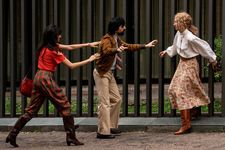 |
| Lidia (Linda Caridi) and Aldo (Luigi Lo Cascio) with Vanda (Alba Rohrwacher) |
What you actually see on the screen in the end is a kind of middle way between the editing process and the screenplay. In terms of the meaning of the story, the two protagonists of the novel are portrayed as victims of a certain period in time, of the 1960s, when the whole notion of the couple was subject to a lot of critical analysis. So instead, in the screenplay what we decided to do was place the blame for the separation squarely on the shoulders of the husband, on the figure of Aldo. I thought it would be more interesting to see a man being held accountable for his actions, rather than blaming them on the period in which they took place.
AKT: Very much so. I felt that difference from the novel and I was very appreciative that you did that. Because men like Aldo are everywhere. And they are nowhere in cinema! I was trying to think of someone. I came up with some of the roles played by Jean-Pierre Bacri. This kind of behaviour of Aldo is never shown in films. I loved that and really appreciate what you did.
DL: Thank you.
AKT: Also your choice of actor [Luigi Lo Cascio] is great. I’ll remember him forever in [Paolo Virzi’s] Human Capital as the professor. He plays perfectly this man who uses passivity as his weapon.
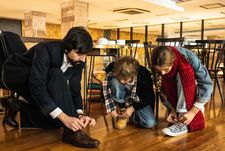 |
| Aldo (Luigi Lo Cascio) with the children older Sandro (Giovannino Esposito) and Anna (Sveva Esposito) lacing up |
DL: Yes, you said that perfectly, that Aldo uses his passivity as a kind of weapon. Placing all the blame on the other person. Therefore all of his aggressiveness is expressed through this manner of diminishing the other person through indifference and through silence. Through delegitimising the other person; showing that they have no effect upon him. And by being so passive, he is somehow making it look as if they don’t exist. And this makes the wife crazy angry. As if she has no right to an explanation, as if she has no right to argue with him.
In the first part this is portrayed in an expansive sense. He’s still a very vital man, full of energy, expanding toward the outside world. In the second part instead, it’s more mortifying in a way. They’re just rotating around a void. He can no longer have any impact on his wife through indifference. The problem really is that the couple had remained together. The title, Lacci, Ties, is really quite appropriate because once you’re tied together you can’t really come apart, even when the relationship is toxic.
AKT: Right, also because of the children. When he says to Lidia [Linda Caridi], “we have no ties” or something like that, It’s equally horrible. He is like a fort, he fortified himself with so many defences and everything he does is an attack on everybody else. There’s a great moment when his wife points out “Your little daughter just told you and showed you her drawing about a dream in which she died and you say ’nice colours’! The specificity, the details are terrific. Did you work with these clusters of truth in mind?
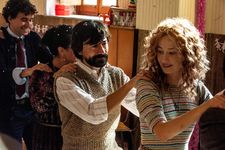 |
| Aldo (Luigi Lo Cascio) joins Vanda (Alba Rohrwacher) in the conga line: “It’s a dance of love but it’s also a kind of dance macabre, something that you might find in a horror film.” |
DL: The main instrument that I used was to remember the impact the book had on me the first time that I read it. The first time I read it was like five or six years ago and it felt like twenty stabs to the heart.
AKT: For me too.
DL: I wanted to maintain this in the film. And maybe to add some others. And to remember the impact that these stabs had on me. I think that these were deep truths upon what it means to be together, on what the meaning of the family is. For me it was crucial to keep those points. There’s a risk, actually, as you work on a film. It gets consumed over and over again, that you might get tired of certain lines, you might get tired of certain situations. They get consumed, they get eaten up. But I think I always at every moment wanted to maintain that first impression and not to lose the impact of that first reading. The detail that you mentioned is not in the book, but it very much resembles the moments in the book.
AKT: Another one of those moments is the gift of the little box with the pendant necklace in it. And the mother doubts he chose it himself. That is one of those stabs you mentioned. He can’t even choose presents for his own children anymore! That’s how much and how fast he removed himself emotionally. But I want to get to your start of the film. The book begins with her letter. You have a carnivalesque dance sequence. There is this song, which I recognized, because I was in the late Seventies in a children’s ballet. The “Letkiss” which is this quite horrible Finnish Conga line dance. It follows us through the film, which is brilliant and a bit horrifying. Tell me about the song!
 |
| Vanda (Laura Morante) with Aldo (Silvio Orlando) later in life on vacation |
DL: You know, I wrote that sequence at the very start and I wanted the film to begin with it. But as often happens when we are in the preparatory stages, my assistants ask, well, what kind of dance do you want to go with it? Because I didn’t have any particular choreography in mind. So watching it on YouTube I was very struck by the music. First of all, it belongs very much to our collective memory from that period. And the fact that it’s a dance of love but it’s also a kind of danse macabre, something that you might find in a horror film.
AKT: Totally.
DL: It’s one of those dances everyone has to dance together so it forces you to take certain steps, very much like a love relationship forces you to take certain steps. It also recalled a film of [Antonio] Pietrangeli, I Knew Her Well. A film that I like very much and a sequence I almost copied was played twice there. Once it’s played with the music and the second time it is sung. I adore this film very much and it’s a music that even if you don’t know it, you recognize it.
AKT: Well put! It’s also a bit like Howard Hawks’s Ball of Fire. With Barbara Stanwyck and Gary Cooper.
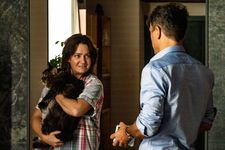 |
| Labes in the arms of Anna (Giovanna Mezzogiorno) with Sandro (Adriano Giannini) |
DL: Yes!
AKT: And all the scientists are dancing in this conga line! I would like to talk about the costumes. Especially Alba’s costumes. Your costume designer worked on a number of fairy-tale films. He did the Basile one, [Matteo Garrone’s] Tale of Tales, and also worked [with Carlo Poggioli] on Terry Gilliam’s The Brothers Grimm. As much as the clothes Alba wears are perfectly Seventies, they also have a tale quality to them, which I liked very much because it fits with the period of Seventies, Eighties. How did you work with your costume designer?
DL: Yes, Massimo [Cantini Parrini] is a great costume designer. In fact he was one of the five nominees of the Academy Award for best costume design for [Garrone’s] Pinocchio.
AKT: Another fairy tale, yes!
DL: He’s a great costume designer, he is young, he has fantastic experience, which is why I chose him. I thought he’d be right to do something that wasn’t a fairy tale for a change. What’s very difficult to do when you’re making a film that is contemporary or almost contemporary, there’s a risk of losing a kind of creativity or inventiveness. And you have to take great risk. The risk is that you take the wrong taste. I think Massimo made many very interesting choices, one for example being the hair, just the small touches that he uses.
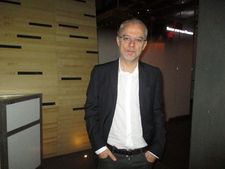 |
| Daniele Luchetti in New York for Those Happy Years Photo: Anne-Katrin Titze |
The way that he does the hair of Alba and Laura Morante, the same character at an older age, using wigs that are kind of similar but in a dialogue with each other. In taking these risks, Massimo is someone who gives me courage when I’m making the film, even though I might think the idea might seem a little bit extravagant, it always works in the end. He has great taste, not to mention the fact that he really knows the craft well, he really knows his fabrics.
AKT: It shows. I think the clothes worked extremely well. You made some changes to Aldo’s profession. In the book, if I remember correctly, he has a career that spans from being a teacher, a lecturer at university, working for radio and for television. You chose the radio for him and added some interesting titbits. I think once you have him talk about F. Scott Fitzgerald’s Tender is the Night.
DL: Yes!
AKT: It’s a perfect little mirror for the breakup of a marriage. Also the fairy tale of the chocolate road, that you may have invented, that makes us realise that the scene on the staircase, where the two women meet, is actually what we think it is. These are lovely touches.
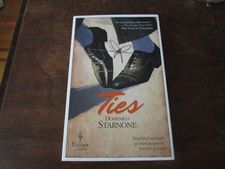 |
| Daniele Luchetti on Domenico Starnone’s novel Ties: “We decided to change some things but decided to remain very faithful to the structure.” Photo: Anne-Katrin Titze |
DL: What I wanted to be the leading factor was the word, the voice in the film. In the book we have all those letters from Vanda, which are a very strong voice. I think one of the mistakes that is often made in the adaptation of a book is the temptation to transform words into actions. What I wanted to do instead was to use the word as a vehicle of action. The word as something that defines the characteristics. The characters all talk a great deal and even when they’re far apart from each other, I thought that the radio was the perfect medium to express this.
A radio program speaks directly to the soul. The radio is for people who are listening to it alone, maybe while they’re making breakfast or going to bed. It’s also a very confidential kind of medium. It was a great tool to use. Although this has really nothing to do with the film, I’m thinking of podcasts and how podcasts are so much a part of our daily lives, that they are whispering into our ears. The radio communicates to you while your eyes are closed. If there is such a thing as a silent film, radio might be considered a kind of blind film.
AKT: Good choice of profession for this film. Aldo has one line that struck me in particular. He is very truthful, talking to his friends and he says “It’s not easy to suffer in a nice way.”
DL: I think that’s a very key line. I think that I kept that scene in the movie only so that you could hear this line. There’s a big deep truth in it. There’s a truth about suffering, but also the vanity that is inherent to that line. The character is very vain, he is thinking that others are changing only because of me. I am so important to their lives that only because of me their lives might transform into something sad, unbearable, and unsustainable.
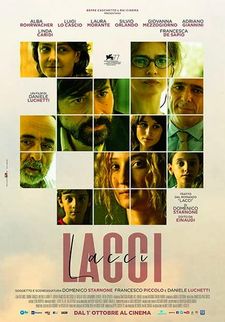 |
| Lacci poster |
AKT: A word about Labes! He puts options about the ending into our heads.
DL: I think one of my main concerns using a term like that was that it could be very hard to translate. There’s a risk when you have a play on words that’s too specific, then it might be hard for others to grasp when the film goes out into the world. I kept it though because I thought it was very interesting that within the name of a cat you find one of the keys of the film. There are other keys, hidden keys, the photographs for example and three or four objects which have hidden meanings and I think that they helped to make the film more concrete.
AKT: Yes, the objects are important - the magical box! I think the translator of Ties into English, Jhumpa Lahiri, she mentioned that she saw the novel as a Chinese box, or a box in a box in a box. Some of the sentences are like boxes. Vanda says “I don’t like a thing about my life. Not you. Not myself. Not even the kids.” That plus the fact that she fought all her life so hard for what she didn’t want. I don’t want to leave any of those important lines out of our conversation, so I am throwing some of these out of the boxes at you!
DL: That’s something you find in the screenplay that’s not in the book but is generated by the book. Once you sort of have the green light to express the cruelty of the characters. Often we’re indulgent toward our characters, making them seem very understanding, very charming, very comprehensive. But in this case we are dealing with characters who are not particularly empathetic but that are very authentic.
AKT: Very very much so. Alba is great, and authentic, as always. I’ve had a number of conversations with her. What’s coming up for you?
DL: Right now I am shooting the third season of [Saverio Costanzo’s] My Brilliant Friend. And what I have slated for the beginning of next year is another novel by Domenico Starnone, Confidenza, Confidence [which has also been translated by Jhumpa Lahiri, our translator Michael Moore added. He also mentioned that Jhumpa’s own new novel Whereabouts includes many suitcases, because of Domenico].
AKT: Thank you so much for the conversation!
DL: Thank you very much Anne-Katrin! Have a nice day, bye-bye!





















